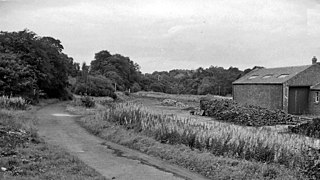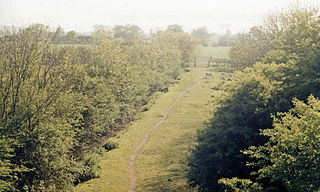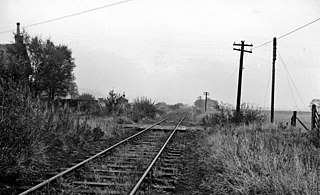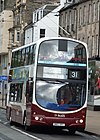
Brynkir railway station was opened by the Carnarvonshire Railway on the western edge of the village of Bryncir, Gwynedd, Wales.

Balerno railway station was opened in 1874 and served the area of the village of Balerno that now forms part of the city of Edinburgh. Although primarily built as a goods line, with a dedicated goods station at Balerno, serving the many mills on the Water of Leith, a passenger service was provided by the Caledonian Railway using the Balerno Loop and after grouping by the London, Midland and Scottish Railway, seeing formal closure to passenger traffic shortly after nationalisation. The station was the only one with a separately served goods station on the 'loop' line and lay in rural surroundings that had been popular with families having a day out in the country.

Cassington Halt was a single platform halt opened by the Great Western Railway on 9 March 1936 on the Oxford, Witney and Fairford Railway to serve the village of Cassington, Oxfordshire, just south of the A40.

Golf Club House Halt railway station, also known as Banff Golf House Halt railway station was opened in 1914. The halt was located close to the town of Banff's golf club on the links. The line from Tillynaught opened in 1859 and a temporary terminus opened at Banff on 30 July 1859 and a permanent station opened in 1860. There was a single platform at the Golf Club House Halt, located on the shore side of the line and no provision for goods traffic. The OS map of 1902 shows a 'Halt' at the site of the 1914 platform without indicating any structure at the site.

Killochan railway station was located in a rural part of South Ayrshire, Scotland and mainly served the nearby Killochan Castle estate. The Killochan bank is the name given to this section of the line, running from Girvan on an uphill gradient to just north of the old station site. Maybole is around nine miles away and Girvan two miles.

Bullers O'Buchan Platform railway station also known as Bullers O'Buchan Halt railway station was a railway station serving visitors to the Bullers of Buchan, a spectacular collapsed sea cave, and to the old fishing village. The station was located 6 miles (9.7 km) south of Peterhead in Buchan, Aberdeenshire, Scotland.
Kirkton Bridge Halt railway station or Kirkton Bridge Platform railway station was a request stop on the Fraserburgh and St Combs Light Railway, Aberdeenshire. It was opened in 1904 as Kirton Bridge Halt, later renamed as Kirkton Bridge Platform, on the links to serve the Fraserburgh golf course users and tourists a year after the line's other stations had opened. The 1948 timetable gives the station name as Kirkton Bridge Halt.

Colinton railway station was opened in 1874 and served the area of the then village of Colinton that now forms part of the city of Edinburgh, with Colinton House nearby. Although primarily built as a goods line to serve the many mills on the Water of Leith, a passenger service was provided by the Caledonian Railway using the Balerno Loop and after grouping by the London, Midland and Scottish Railway, seeing formal closure to passenger traffic shortly after nationalisation.

Juniper Green railway station was opened in 1874 and served the area of the then village of Juniper Green that now forms part of the city of Edinburgh. Although primarily built as a goods line to serve the many mills on the Water of Leith, a passenger service was provided by the Caledonian Railway using the Balerno Loop and after grouping by the London, Midland and Scottish Railway, seeing formal closure to passenger traffic shortly after nationalisation. The station lay in rural surroundings despite being only a short distance from the centre of Edinburgh and had been popular with families having a day out in the country.

Currie railway station was opened in 1874 and served the area of the village of Currie that now forms part of the city of Edinburgh. Although primarily built as a goods line to serve the many mills on the Water of Leith, a passenger service was provided by the Caledonian Railway using the Balerno Loop and after grouping by the London, Midland and Scottish Railway, seeing formal closure to passenger traffic shortly after nationalisation. The station was the largest on the 'loop' line and lay in rural surroundings and had once been popular with families having a day out in the country.

Ravelrig Junction Platform railway station or Ravelrig Halt was originally opened in 1884 as a two platform station on the Shotts line on the edge of the Dalmahoy Estate in an area that now forms part of the city of Edinburgh. It stood just to the west of Ravelrig Junction that served the Balerno Loop Line. After closure in 1920 Ravelrig Platform for Dalmahoy Golf Course was opened at the same site around 1927 as a single platform when the Dalmahoy Estate became a hotel with a golf course, however it is stated to have closed in 1930. The site may have also served a military purpose.

Torrance railway station was opened in 1879 on the Kelvin Valley Railway and served the area of the village of Torrance in East Dunbartonshire until 1951 for passengers and 1959 for freight.

Balmore railway station was opened in 1879 on the Kelvin Valley Railway and served the coal mining area, farms and the village of Balmore in East Dunbartonshire until 1951 for passengers and to freight on 31/7/61.
Seven Stars Halt railway station was located in the streets of Welshpool on the corner of Union Street. Seven Stars was an unstaffed request halt on the narrow gauge Welshpool and Llanfair Light Railway. It had a single ground level platform on the single track line, a name board, a sign warning passengers not to board until the train had stopped and a lean-to waiting shelter with a fence.

Bardowie railway station was opened in 1905 on the Kelvin Valley Railway, later than most of the other stations which had opened with the line itself in 1879. It served the hamlet of Bardowie and the coal mining area, farms, etc. in East Dunbartonshire until 1931 for passengers and to freight on 31 July 1961.
Twechar railway station was opened in 1878 as Gavell on the Kelvin Valley Railway and renamed Twechar in 1924. The station served the hamlet of Twechar and the coal mining area, Gavell House and Farm, etc. in East Dunbartonshire until 1951 for passenger travel. and to coal traffic to the Cadder Yard until 1966.
Leadhills railway station was opened on 1 October 1901 as the intermediate stop on the Leadhills and Wanlockhead Light Railway and served the lead mining area, farms and the village of Leadhills circa 5.5 miles (8.9 km) WSW of Elvanfoot railway station in South Lanarkshire until 2 January 1939 for passengers and freight. Until Wanlockhead station opened Leadhills was the highest standard gauge adhesion station in the United Kingdom.
Wanlockhead railway station was opened on 1 October 1902 as the terminus on the Leadhills and Wanlockhead Light Railway and served the lead mining area, farms and the village of Wanlockhead. Elvanfoot railway station in South Lanarkshire was the junction for the branch and was located on the west coast main line. It remained open until 2 January 1939 for passengers and freight. When Wanlockhead station opened in 1902, a year after Leadhills station, it became the highest standard gauge adhesion station in the United Kingdom at 1,413 ft (431 m), seven miles and 24 chains from Elvanfoot.
Calderpark Halt railway station or Calderpark for Glasgow Zoo (NS679625) served Calderpark Zoo opened in 1947 on the old estate of Calderpark and the Baillieston area of Glasgow, Scotland on the Glasgow, Bothwell, Hamilton and Coatbridge Railway between Shettleston and Hamilton. Glasgow Zoo closed in 2003.
Badgeworth railway station served the village of Badgeworth, Gloucestershire, England, from 1843 to 1846 on the Birmingham and Gloucester Railway.

















